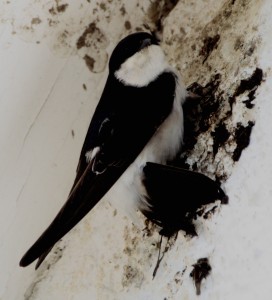 We tend to accept house martins swooping up under the eaves of houses and building their nests that are largely made of mud. Like the swallows, such mud nests need very many beakfulls of mud and with the house martin this is around 1,000. Such is the importance of the right kind of mud that this may be an important factor as to where the birds actually nest. One of the many mysteries about house martins is their choice of nest site. For example our house now has thirteen artificial nestboxes under the eaves to encourage the birds to get over the problem of finding mud. Yet every year there are examples where a pair of house martins will occupy an artificial nestbox where adjacent to it, sometimes even attached, another pair will start from scratch and build the traditional nest of mud! When you think how much energy is needed to build a mud nest whilst there are still unoccupied artificial nestboxes nearby is a mystery indeed.
We tend to accept house martins swooping up under the eaves of houses and building their nests that are largely made of mud. Like the swallows, such mud nests need very many beakfulls of mud and with the house martin this is around 1,000. Such is the importance of the right kind of mud that this may be an important factor as to where the birds actually nest. One of the many mysteries about house martins is their choice of nest site. For example our house now has thirteen artificial nestboxes under the eaves to encourage the birds to get over the problem of finding mud. Yet every year there are examples where a pair of house martins will occupy an artificial nestbox where adjacent to it, sometimes even attached, another pair will start from scratch and build the traditional nest of mud! When you think how much energy is needed to build a mud nest whilst there are still unoccupied artificial nestboxes nearby is a mystery indeed.
Another mystery is why house martins will give way to house sparrows in that the latter will take over their nests when they are half built. Male house martins tend to come back from their winter quarters first and generally the older birds. Then the females arrive and a pair will often take over their old nest even if it needs plenty of refurbishment. Despite all this even when the final nest is half or even more complete along will come a pair of house sparrows and just take over and push out the house martins. This is surprising as the house martins are very aggressive over their defences to other house martins. They are also very faithful and young birds from a first brood will help to feed young of the second brood when they are still in the nest.
However, perhaps the biggest mystery of all over house martins is just where they go to roost in the summer and, even more remarkable, where they go in the winter months. For example if you look at sand martins and swallows both these birds roost, sometimes in large numbers, in places such as reedbeds. This has been proved by ringing large number of both these birds. However no such roosts have ever been found for house martins and the suggestion is that whilst one bird may be incubating the eggs or very young chicks the other just takes to the wing and sleeps in flight. As for where the house martins go in the winter months, this is one of the biggest mysteries surrounding British birds. We know from ringing that they go to Africa, south of the Sahara, but we do not know exactly where. The suggestion is that they spend all their time on the wing and sleep whilst in flight rather like swifts.
Yet another mystery with these enigmatic birds is why they have decreased in numbers over so many parts of the UK. Quite large colonies have suddenly disappeared whilst others, albeit smaller, have appeared. It may, of course, just be the very large decrease in the numbers of insects in general because of change in habitats, such as farming techniques. Suggestions are that this is a long term decline that has also taken place in other parts of Europe. We can help by putting up artificial nestboxes and not knocking off nests because of the droppings underneath. It seems amazing in this day and age that people still, illegally, knock off such nests when a simple plank underneath will clear up the so called problem of droppings. Why not help a house martin in 2015?
Tags: highland wildlife
